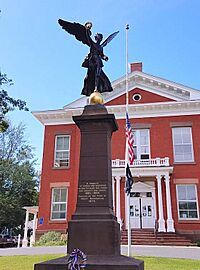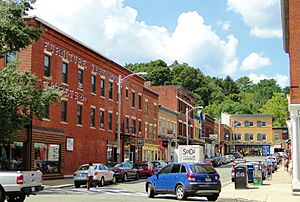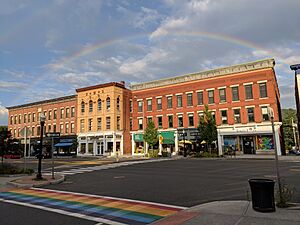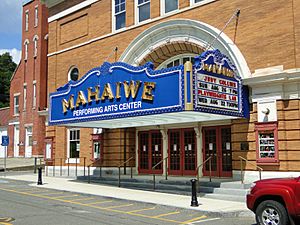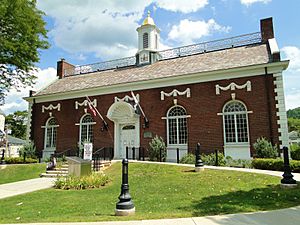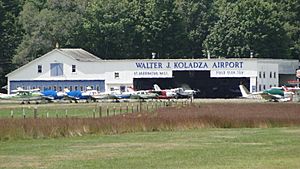Great Barrington, Massachusetts facts for kids
Quick facts for kids
Great Barrington, Massachusetts
|
||
|---|---|---|
|
Town
|
||
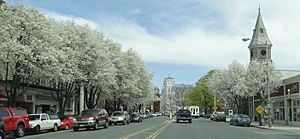
View from Main Street in the spring
|
||
|
||
| Etymology: Village of Great Barrington in Gloucestershire, England | ||
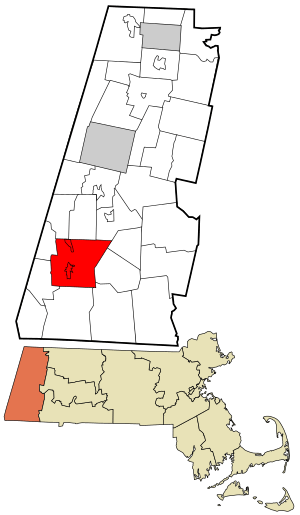
Location in Berkshire County and the state of Massachusetts
|
||
| Country | United States | |
| State | Massachusetts | |
| Region | Western Massachusetts | |
| County | Berkshire County, Massachusetts | |
| Settled | 1726 | |
| Area | ||
| • Total | 45.8 sq mi (119 km2) | |
| • Land | 44.8 sq mi (116 km2) | |
| • Water | 1.0 sq mi (3 km2) | |
| Population
(2020)
|
||
| • Total | 7,172 | |
| • Density | 156.59/sq mi (60.46/km2) | |
| Time zone | UTC-5 (Eastern (EST)) | |
| • Summer (DST) | UTC-4 (EDT) | |
| ZIP Code |
01230
|
|
| Area code(s) | 413 | |
| FIPS code | 25-26815 | |
| GNIS feature ID | 0619420 | |
Great Barrington is a town in Berkshire County, Massachusetts, United States. It's part of the Pittsfield, Massachusetts, area. In 2020, about 7,172 people lived there. Great Barrington is a popular place for summer vacations and is home to Ski Butternut, a ski resort. The town also includes the smaller villages of Van Deusenville and Housatonic.
Contents
History of Great Barrington
Early Days and Native Americans
The Mahican Indians first lived in this area. They called it Mahaiwe, which means "the place downstream." This land was part of an important path connecting Fort Orange (near Albany, New York) with Springfield and Massachusetts Bay.
In 1676, during King Philip's War, Major John Talcott and his soldiers came to the area. They chased a group of Mahican Natives to the Housatonic River. A plaque in Great Barrington today marks where this event is believed to have happened.
In 1724, Captain John Ashley bought the land for £460 and some other items from 21 Native American leaders. The Konkapot River is named after one of these leaders, Conkepot Poneyote.
Becoming a Town
The first European settlers arrived in 1726. From 1742 to 1761, Great Barrington was part of Sheffield. In 1761, it officially became its own town. It was named after a village called Great Barrington in England.
During the summer of 1774, local colonists closed the Berkshire County Court. They were protesting against unpopular British rules. In 1776, Henry Knox passed through Great Barrington. He was moving cannons from Fort Ticonderoga to Boston during the siege of Boston.
A Resort Town and New Ideas
When the railroad arrived in the late 1800s, Great Barrington became a popular resort. Wealthy families built large homes here, similar to those in Lenox and Stockbridge. These homes were called Berkshire Cottages.
One of the first big estates was built by David Leavitt, a banker from New York City. He also helped develop the local Housatonic Railroad. Later, Searles Castle was built in 1888. In 1895, Colonel William L. Brown gave the town a statue of a newsboy, which is now a famous landmark.
World's First AC Power System
In 1885, an electrical engineer named William Stanley, Jr. lived in Great Barrington. He worked for George Westinghouse. Stanley believed that alternating current (AC) was better than the direct current (DC) system used by Thomas Edison.
In March 1886, Stanley set up the world's first working AC lighting system with transformers. He used a generator to create 500 volts of electricity. This power was sent through lines strung from trees along Main Street. At each business, Stanley's new transformers lowered the voltage to 100 volts for lights. This system could light 23 businesses with very little power loss over 4,000 ft (1,200 m). This successful demonstration became the basis for the AC power systems Westinghouse started using later that year.
Alice's Restaurant Story
The famous 18-and-a-half-minute song "Alice's Restaurant" by Arlo Guthrie is based on real events that happened in Great Barrington. These events took place in the mid-1900s. The Old Trinity Church, where Ray and Alice Brock lived at the time, is now owned by Guthrie. It is located at 4 Van Deusenville Road in Great Barrington.
Recent Events
On May 29, 1995, a strong tornado hit the town. It caused damage and sadly, three people lost their lives.
In 2009, Great Barrington was recognized as an Appalachian Trail Community. This means it's a welcoming stop for hikers on the famous Appalachian Trail.
A new fire station opened in 2010 on Route 7. It replaced an older, smaller station. This new $9.1 million building is also used for community events and as a center for emergencies in southern Berkshire County.
In 2011, the town celebrated its 250th anniversary with a big parade and other events.
From 2011 to 2016, the "Main Street Reconstruction Project" improved the town's main road. This included new pavement, sidewalks, and utility upgrades.
In 2023, the town was in the news after police searched the WEB DuBois Regional Middle School. This happened because of a tip about a book called Gender Queer: A Memoir.
Geography and Climate
Town Location
Great Barrington covers about 45.8 square miles (118.6 km2) (45.8 square miles). Most of this is land, with a small amount of water. The town is surrounded by several other towns. It is about 20 miles (32 km) south of Pittsfield and 135 miles (217 km) west of Boston.
Rivers and Mountains
Great Barrington is in the valley of the Housatonic River. Other rivers like the Williams River and Green River also flow into the Housatonic here. To the east, you can see mountains of the Berkshires. These include East Mountain, where the Ski Butternut resort is located, and Monument Mountain. The Appalachian Trail also passes through the southeast part of town.
Roads and Travel
U.S. Route 7 runs through the center of Great Barrington. Other important roads include Massachusetts Route 23, Massachusetts Route 41, and Massachusetts Route 183. The nearest major highway is Interstate 90 (the Massachusetts Turnpike), about 12 miles (19 km) north of town.
Weather in Great Barrington
| Climate data for Great Barrington, Massachusetts (1981–2010 normals) | |||||||||||||
|---|---|---|---|---|---|---|---|---|---|---|---|---|---|
| Month | Jan | Feb | Mar | Apr | May | Jun | Jul | Aug | Sep | Oct | Nov | Dec | Year |
| Mean daily maximum °F (°C) | 33 (1) |
36 (2) |
45 (7) |
58 (14) |
69 (21) |
78 (26) |
82 (28) |
81 (27) |
72 (22) |
60 (16) |
49 (9) |
38 (3) |
58 (15) |
| Mean daily minimum °F (°C) | 14 (−10) |
16 (−9) |
24 (−4) |
35 (2) |
46 (8) |
55 (13) |
59 (15) |
57 (14) |
49 (9) |
38 (3) |
31 (−1) |
21 (−6) |
37 (3) |
| Average precipitation inches (mm) | 3.39 (86) |
2.98 (76) |
3.62 (92) |
3.99 (101) |
4.53 (115) |
4.40 (112) |
4.57 (116) |
4.47 (114) |
4.14 (105) |
4.69 (119) |
3.95 (100) |
3.90 (99) |
48.63 (1,235) |
Great Barrington has a climate with warm summers and cold, snowy winters. The warmest month is July, with average high temperatures around 82°F (28°C). January is the coldest month, with average low temperatures around 14°F (-10°C). The town gets a good amount of rain throughout the year.
Population and People
| Historical population | ||
|---|---|---|
| Year | Pop. | ±% |
| 1850 | 3,264 | — |
| 1860 | 3,871 | +18.6% |
| 1870 | 4,320 | +11.6% |
| 1880 | 4,653 | +7.7% |
| 1890 | 4,012 | −13.8% |
| 1900 | 5,854 | +45.9% |
| 1910 | 5,926 | +1.2% |
| 1920 | 6,315 | +6.6% |
| 1930 | 5,934 | −6.0% |
| 1940 | 5,824 | −1.9% |
| 1950 | 6,712 | +15.2% |
| 1960 | 6,624 | −1.3% |
| 1970 | 7,537 | +13.8% |
| 1980 | 7,405 | −1.8% |
| 1990 | 7,725 | +4.3% |
| 2000 | 7,527 | −2.6% |
| 2010 | 7,104 | −5.6% |
| 2020 | 7,172 | +1.0% |
| 2022* | 7,214 | +0.6% |
| * = population estimate. Source: United States Census records and Population Estimates Program data. |
||
In 2000, Great Barrington had 7,527 people living in 3,008 households. About 27% of households had children under 18. The average age of people in the town was 42 years old. The median household income was $95,490. This means half of the households earned more than this amount, and half earned less.
Economy and Activities
Great Barrington is home to the Ski Butternut resort, which is a popular place for skiing and snowboarding. The Berkshire Humane Society also has facilities in town, helping animals and finding them new homes.
Arts and Culture
Places to Visit
- Bard College at Simon's Rock: A unique college where students can start early.
- First Congregational Church of Great Barrington: An old and historic church.
- Mahaiwe Performing Arts Center: A place to see live shows and movies.
- Monument Mountain: A beautiful mountain for hiking.
- Searles Castle: A grand historic home.
- W.E.B. Du Bois Boyhood Homesite: The childhood home of a famous scholar and activist.
Great Barrington Declaration
The American Institute for Economic Research is located in Great Barrington. In October 2020, this institute held a meeting. Experts discussed different ways governments could respond to the COVID-19 pandemic. This meeting resulted in the Great Barrington Declaration. It suggested protecting those most at risk from the virus and trying to avoid or reduce the harm caused by lockdowns.
Education in Great Barrington
Great Barrington is the largest town in the Berkshire Hills Regional School District. This district also includes Stockbridge and West Stockbridge.
- Muddy Brook Regional Elementary School teaches students from pre-kindergarten to fourth grade.
- W.E.B Du Bois Regional Middle School is for grades five through eight.
- Monument Mountain Regional High School (MMRHS) opened in 1968. It serves high school students from Great Barrington and nearby towns.
The town also has several private schools, like the Rudolf Steiner School and the Great Barrington Waldorf High School.
For higher education, Great Barrington is home to Bard College at Simon's Rock. This was the first college in the country where students could start early. The South County Center of the Berkshire Community College is also here.
Media
Great Barrington has two local radio stations:
- WSBS 860 kHz
- WBCR-LP 97.7 MHz (local variety)
Transportation
Roads and Buses
US Route 7 is the main road in Great Barrington. The town is about 7 miles (11 km) (11 kilometres (6.8 mi)) south of Interstate 90 (the Massachusetts Turnpike). The Berkshire Regional Transit Authority provides bus service throughout Berkshire County. Long-distance bus services like Peter Pan Bus Lines and Greyhound Lines also have stops in Great Barrington. The town is also on the Housatonic Railroad line.
Air Travel
The Walter J. Koladza Airport is in Great Barrington. It serves smaller general aviation aircraft. For major flights, the closest airports are Albany, New York and Bradley near Hartford, Connecticut.
Notable People from Great Barrington
Many interesting people have connections to Great Barrington:
- Karen Allen: An actress known for Raiders of the Lost Ark.
- Jim Bouton: A famous baseball pitcher.
- W. E. B. Du Bois: A very important scholar, activist, and writer.
- Jackson C. Frank: An American folk musician.
- Anson Jones: The last President of the Republic of Texas.
- Pauline Kael: A well-known film critic for The New Yorker.
- Laura Secord: Famous for warning the British about an American attack on Canada.
Sister Cities
Great Barrington has two sister cities, which are towns it shares a special friendship with:
- Ingersoll, Ontario, Canada
- Fada N'gourma, Burkina Faso
See also
 In Spanish: Great Barrington (Massachusetts) para niños
In Spanish: Great Barrington (Massachusetts) para niños




